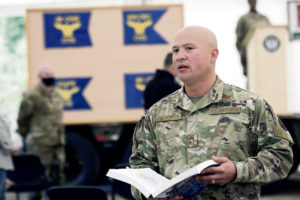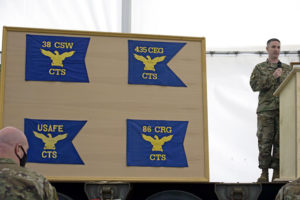
The 435th Construction and Training Squadron celebrated its 70th year, Sept. 3.
To commemorate the milestone, the unit held a ceremony paying homage to its history and heritage by highlighting the squadron’s accomplishments.
The ceremony opened with Lt. Col. Seth Platt, the current 435th CTS commander, reading an excerpt from Brig. Gen. Michael “Mick” McAuliffe, the first U.S. commander of the squadron, formerly known as the 7329th Civilian Service Unit (CSU).
Platt read, “‘Fifty years ago, I had the honor to take part in the 20th anniversary celebration. I had just arrived from Vietnam to become the leader of the CSU as a newly minted captain. Importantly, our accomplishments from then through today have been accomplished with dedication and excellence and the unit enjoys the respect of all who have served and assisted through the skills we bring to the task at hand. In my thirty-year Air Force career this was truly my Camelot duty assignment. My only wish is that the men who I served with were still among us and able to celebrate this moment and this occasion.’”
Upon reading the message from McAuliffe, Platt reflected on his own time with the unit.
“After being here for the past several months, I am starting to understand (McAuliffe) better and understand why he takes such pride in being part of our legacy,” Platt said. “Anyone who has spent any time here can tell there’s something special about the 435th CTS.”
As the keynote speaker, the 435th Air Ground Operations Wing and 435th Air Expeditionary Wing historian, Dr. Jeff McGovern, celebrated the wing’s past and present.
“It’s a privilege for me, as your wing historian, to come be able to speak to you today about the history and the heritage of the 435th CTS,” McGovern said. “You guys have a truly unique history…you’re 70 years old, and that’s not 70 broken years, that’s 70 continuous years of a unit’s history.”
McGovern went on to detail the history of the unit, starting with the Berlin Airlift, an effort following World War II which involved transferring tons of provisions to airfields in West Berlin.

“During the occupation of Germany from 1945 till 1948, Germans and American viewed each other with mutual suspicion,” McGovern said. “The 1948 Berlin Airlift changed that. As an Air Force we were unprepared for the task at hand in many ways. One of those was in manpower, skilled and semi-skilled. We needed mechanics and office workers, we needed labor to load and unload aircraft quickly and efficiently, and we needed construction workers to repair and build airfields. In this time of need we gambled and turned to our former enemy and offered them a chance to work for us. It was a gamble that has paid off ever since.
“How the CTS fits into this story is tied to this new relationship, the establishment of the Air Force in 1947, and the start of the Cold War,” he continued. “When we separated from the Army in 1947, we agreed to let the Army Corps of Engineers provide our overseas and wartime construction capabilities, including airfield construction. Despite best intentions, yesterday just as with today, joint agreements are often trumped by single service requirements. As the tensions rose between the Soviet Union and the recently established NATO, the U.S. Air Force, starting in 1950, needed to build air bases on this side of the Rhine River. The Army was unable to meet that need and it is this gap in capability that required on Sept. 8, 1950, the activation at Rhein-Main Air Base, now Frankfurt International Airport, of the first iteration of the CTS, the 7329th Labor Service Unit (Engineer Construction).”
Once established, the German-led and manned 7329th LSU took on the enormous task in constructing what was known then as Ramstein Air Station and Landstuhl Air Base. Afterward, the unit had many redesignations, the first being the 7329th CSU. In 1971, a U.S. Air Force flight from Wiesbaden was reassigned to the 7329th, initiating the redesignation to the 7002d Civil Engineering Flight. It is at this point that the Air Force officially acknowledged the creation of the 435th CTS, McGovern said.


